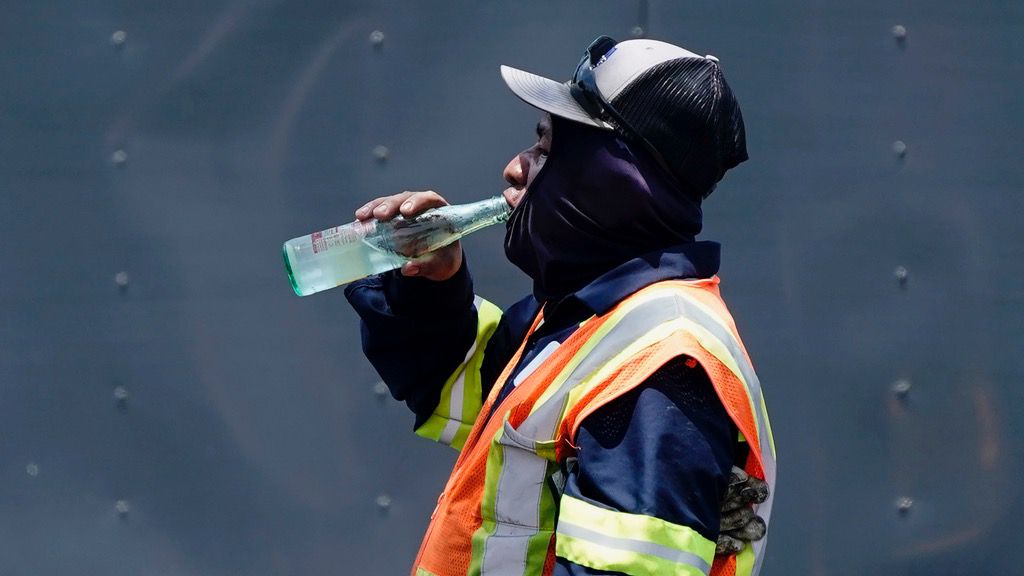Extreme heat alerts affected tens of millions of people in the United States on Tuesday as cities including Chicago broke records at the start of a week of sweltering weather.
New York Gov. Kathy Hochul said Tuesday that she has activated the National Guard to assist in any heat emergencies that develop over the next several days.
“This is a time of significant risk and we’re doing our best to make sure that all lives are protected,” she said. “Heat like this can be dangerous – New Yorkers should take every precaution to stay cool this week. Stay hydrated, avoid excessive outdoor activity and, if needed, visit a cooling center near you.”
Record temperatures are possible in Western, Central, Northern New York, and the Capital Region. Temperatures are likely to peak through Thursday, but will linger in some places into the weekend. The “feels like” temperature values are looking to approach the low 90’s to over 100 degrees today through Friday.
Friday will vary between the mid 70’s in the North Country with the potential to exceed 100 degrees in the Mid-Hudson region. Saturday will be in the mid 70’s in the North Country and range anywhere from the lower 80’s to the mid 90’s in the rest of the state. Overnight temperatures will remain warm in the higher 60’s to mid 70’s, not allowing much relief from the heat tonight through Friday night. Saturday and Sunday night will range in the high 50’s to the mid 70’s statewide.
“Every region of upstate is going to be hit with a over 100-degree real feel. How are we preparing?" Gov. Hochul said during a news conference Tuesday. "As I said, this is an all-of-government approach and we need to focus all of our energy on protecting the health and safety of New Yorkers. Today, I'm announcing we are opening the State's Emergency Operations Center, which is a statewide hub to monitor conditions and share resources. This includes constant communication with our county leaders. I have been in contact with all the major principals across this corridor yesterday, letting them know that we are ready to help them.”
“I know New Yorkers are tough. We think we can handle it all without breaking a sweat — and we probably will," Hochul continued. "But we'll be able to get through this because we'll be prepared. This is a historic heat wave that will be different by so many measurements. As I said, the real feels-like temperature is going to be over 100 degrees — even starting today in upstate New York.”
Chicago broke a 1957 temperature record Monday with a high of 97 degrees Fahrenheit (36.1 degrees Celsius). Hot and muggy conditions will continue this week with peak heat indexes near 100 F (37.7 C) at times, the National Weather Service in Chicago said in a post on the social platform X.
The U.S. last year saw the most heat waves, consisting of abnormally hot weather lasting more than two days, since 1936. Officials warned residents to take precautions.
Much of the Midwest and Northeast were under heat warnings or watches, with officials announcing the opening of cooling centers and urging people to limit outdoor activities when possible and to check in with family members and neighbors who may be vulnerable to the heat.
The heat has been especially dangerous in recent years in Phoenix, where 645 people died from heat-related causes in 2023, which was a record. Temperatures there hit 112 F (44.4 C) on Saturday. Weather service forecasters say the first two weeks of June in Phoenix were the hottest start to the month on record there.
A meteorologist with the National Weather Service in Phoenix, Ted Whittock, advised reducing time outdoors between 10 a.m. and 6 p.m., staying hydrated and wearing light, looser fitting clothing. More than 100 cooling centers were open in the city and surrounding county, including two new overnight ones.
In Southern California, firefighters have increased their containment of a large wildfire that is burning in steep, hard-to-reach areas in mountains north of Los Angeles. But hot, dry, windy weather could challenge their efforts Tuesday. Wildfires also burned in New Mexico, prompting the evacuation of a village of 7,000 people.
The warming temperatures come amid growing concern about the effects of extreme heat and wildfire smoke. The nonprofit Center for Biological Diversity on Monday sent a petition to the Federal Emergency Management Agency asking it to recognize extreme heat and wildfire smoke as major disasters.
The agency did not immediately issue a specific response to the petition. A FEMA spokesperson for the western U.S. states said there was nothing that would preclude an emergency declaration for extreme heat, but noted that there would need to be an immediate threat to life and safety that local authorities could not respond to.
While much of the U.S. swelters, late-season snow was forecast for the northern Rockies on Monday into Tuesday. Parts of Montana and north-central Idaho were under a winter storm warning. As much as 20 inches (51 centimeters) was predicted for higher elevations around Glacier National Park.
Meanwhile, a fresh batch of tropical moisture was bringing an increasing threat of heavy rain and flash flooding to the central Gulf Coast.
Hurricane season this year is forecast to be among the most active in recent memory.



